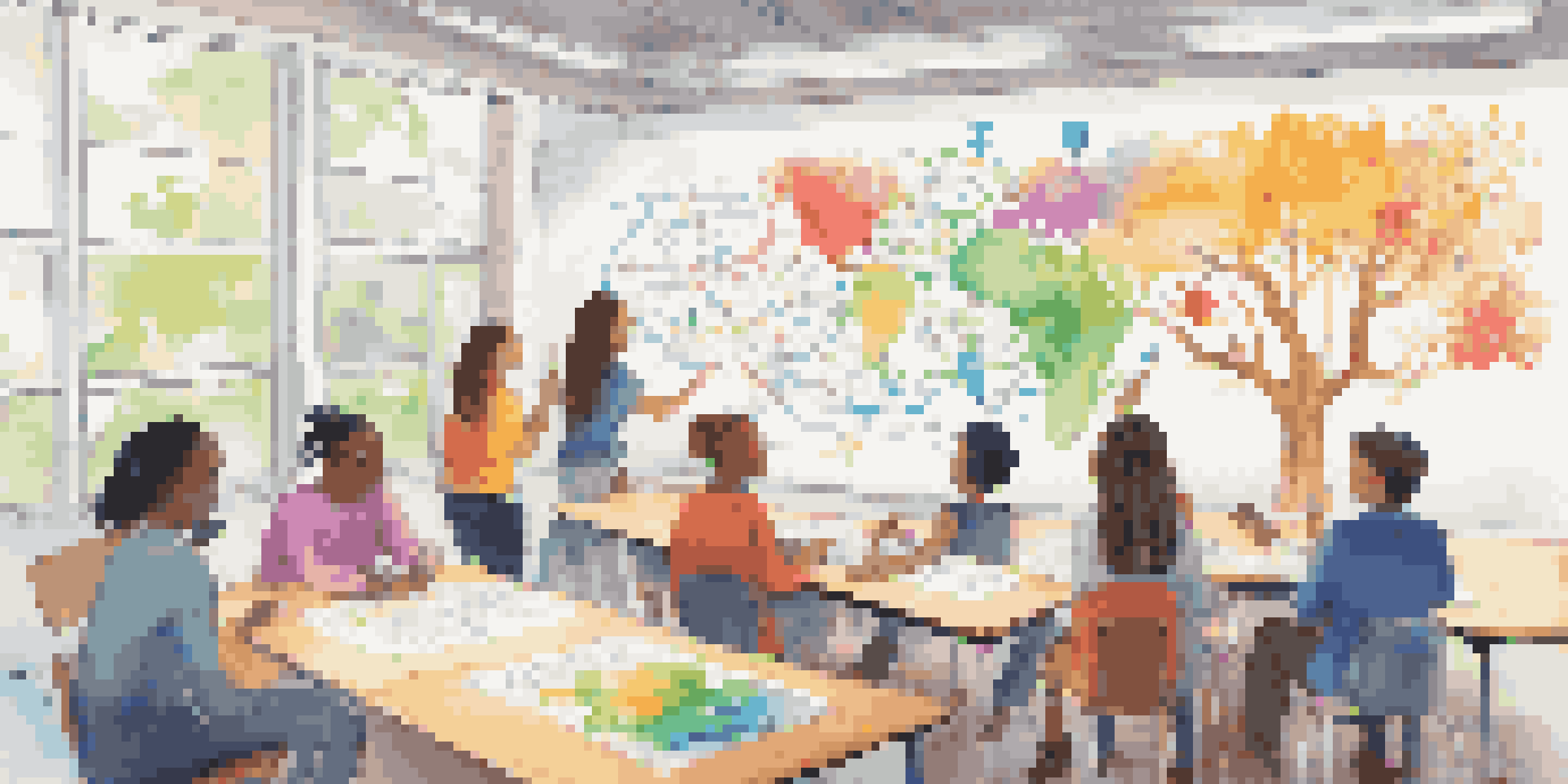Using Mind Maps in Educational Learning Spaces

What are Mind Maps and Their Benefits in Education?
Mind maps are visual tools that help organize information in a structured way, making complex ideas easier to digest. They allow students to see the connections between concepts, which can enhance understanding and retention. This method is particularly beneficial in educational settings where students often juggle multiple subjects and ideas.
Mind mapping is a technique that can help you organize your thoughts and visually represent information, making it easier to understand and remember.
Using mind maps can stimulate creativity and critical thinking. When students create a mind map, they engage in a process that requires them to analyze and synthesize information, fostering deeper learning. This visual representation can also cater to various learning styles, making education more inclusive.
Furthermore, mind maps can improve collaboration among students. When working together on a mind map, learners can share ideas and perspectives, which promotes teamwork and communication skills. This collaborative aspect makes learning not just an individual endeavor but a shared experience.
Integrating Mind Maps into Classroom Activities
Incorporating mind maps into classroom activities can transform standard lessons into interactive experiences. For instance, teachers might start a new topic by asking students to brainstorm what they already know, then build a mind map together. This approach creates a foundation for deeper exploration and discussion.

Mind maps can also serve as a great tool for summarizing lessons. At the end of a class, students can create a mind map that encapsulates the key points covered, reinforcing their learning. This not only helps with retention but also allows for quick revisions before exams.
Mind Maps Enhance Learning Retention
Mind maps visually organize information, helping students understand and remember complex concepts.
Another effective use of mind maps is for project planning. When students work on group projects, they can use mind maps to outline tasks, assign roles, and visualize timelines. This method enhances organization and ensures everyone is on the same page, leading to more successful outcomes.
Mind Maps and Student Engagement: A Winning Combination
One of the standout benefits of using mind maps is the boost in student engagement. Visual learning aids like mind maps can capture students' attention, making lessons more dynamic and enjoyable. When students are actively engaged, they are more likely to participate and absorb the material.
The mind is not a vessel to be filled, but a fire to be kindled.
Moreover, mind maps encourage autonomy in learning. Students can create their own mind maps based on their interests, allowing them to take ownership of their education. This personalized approach not only boosts motivation but also cultivates a love for learning.
In addition, the collaborative nature of creating mind maps can enhance peer relationships. As students work together to build these visual aids, they develop communication and social skills that are essential in and out of the classroom. This teamwork fosters a sense of community and belonging among students.
Challenges and Solutions in Using Mind Maps
While mind maps are incredibly useful, there can be challenges in implementing them effectively. Some students may initially feel overwhelmed by the visual format, especially if they are accustomed to traditional note-taking. It's essential for educators to provide guidance and practice to help students adjust.
Another challenge is ensuring that mind maps are used consistently across different subjects. To address this, teachers can collaborate to incorporate mind mapping strategies into their curricula, creating a unified approach. This consistency can help students see the value of mind maps in various contexts.
Boosting Engagement Through Collaboration
Creating mind maps fosters collaboration among students, enhancing their communication skills and teamwork.
Additionally, technology can play a role in overcoming these challenges. There are numerous digital tools available that facilitate the creation of mind maps, making the process more accessible and engaging for students. Educators can introduce these tools gradually, allowing students to gain confidence in using mind maps.
Using Mind Maps for Personal Study Techniques
Mind maps are not just for group activities; they can also be powerful personal study tools. Students can create individual mind maps to outline their study materials, breaking down information into manageable chunks. This method helps them focus on key concepts without feeling overwhelmed.
When preparing for exams, students can use mind maps to visualize the relationships between topics. This holistic view can help them identify gaps in their knowledge and prioritize their study efforts effectively. It’s a proactive way to approach learning that empowers students to take charge of their education.
Moreover, personalizing mind maps allows students to incorporate their own style and preferences. Whether it's using colors, images, or symbols, this individual touch can make studying more enjoyable and memorable. By connecting personally with the material, students are more likely to retain information.
Mind Maps in Remote Learning Environments
With the rise of remote learning, mind maps have proven to be an invaluable resource. They can help students organize their thoughts and ideas, especially when participating in virtual classes where distractions abound. Mind maps provide a structured way to keep track of information in a less-than-ideal learning environment.
Teachers can leverage mind mapping tools in online platforms to facilitate collaboration among remote students. By creating shared mind maps, students can contribute their insights and work together, mimicking the interaction of a traditional classroom. This keeps the learning experience dynamic and engaging.
Adapting Mind Maps for Remote Learning
In remote learning environments, mind maps help students stay organized and engaged despite potential distractions.
Additionally, mind maps can serve as effective visual aids in online presentations. Students can use them to outline their projects or topics, making their presentations more organized and coherent. This visual support can enhance understanding for both the presenter and the audience in a virtual setting.
The Future of Mind Mapping in Education
As education continues to evolve, the role of mind maps is likely to expand. With advancements in technology, we may see even more interactive and engaging mind mapping tools that cater to diverse learning needs. This adaptability will make mind maps an essential component of modern education.
Moreover, as educators recognize the value of visual learning strategies, mind maps may become a standard practice in classrooms around the world. By embracing this approach, we can foster a generation of critical thinkers who are well-equipped to tackle complex problems.

Ultimately, the future of mind mapping in education is bright. By encouraging creativity, collaboration, and deeper understanding, mind maps can transform the learning experience, making it more enjoyable and effective for students everywhere.